DMM Sanwa PS8a
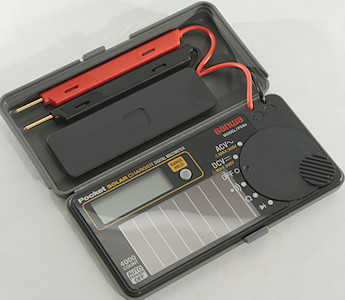
This is a small pocket DMM with voltage and ohms, but without current. The meter is equipped with a recharge battery and a solar panel.
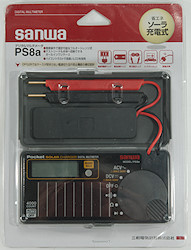
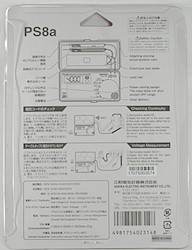
The meter was in a transparent retail pack. On the back is a some explanation about using the meter.

In the pack was the meter and a manual in Japanese and English.

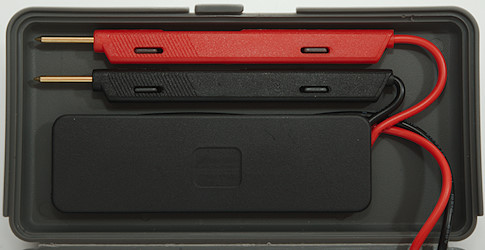
The probes are shaped a bit unusual to make for a very neat storage in the box.
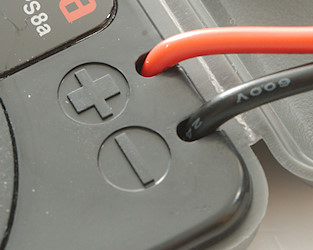
There is no soft strain relief where the leads come out of the meter, also note the lid, the hinge is plastic that folds.
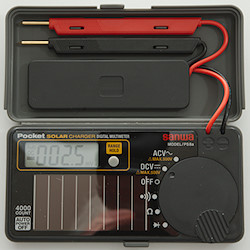
The range switch is easy to turn when using the tab on it, but it is necessary to hold the meter or it will rotate.
The design of the switch wheel prevents the lid from being closed, except in the off position.
There is a fairly large solar panel on the front of the meter, this is used to recharge the battery.
According to the manual the charge times are:
- Window in cloudy conditions (5000 lux): 12 hours charge gives 3 hours usage.
- 10cm from 2x15W fluorescent lamp (10000 lux): 5 hours charge gives 5 hours usage.
- Window in bright sun (30000 lux): 5 hours charge gives 6 hours usage.
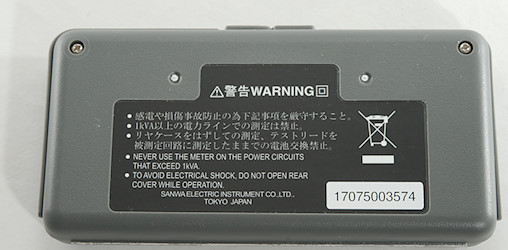
The meter do not have a CAT rating on it, but there is a warning on the back to only use it on low power circuits (Below 1kVA).
Display

The above picture shows all the segments on the display, not all are used.
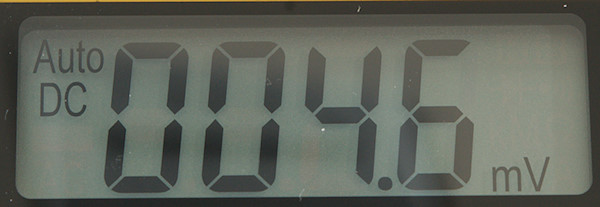
Typical display during usage, it will show the selected range and value.
Functions
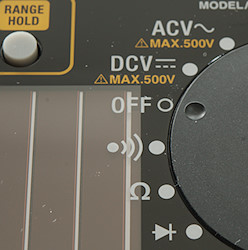
Buttons:
- Range hold: Will select manual ranging and change range, hold down to enable auto ranging again.
Rotary switch:
- ACV: AC voltage
- DCV: DC voltage.
- Off: Meter is turned off
 : Continuity.
: Continuity.
 : Ohm.
: Ohm.
 : Diode.
: Diode.
Input

This meter only have a red and black probe coming out, no other connections.
Measurements
- Volt and frequency
- 1V AC readings is 5% down at 1.8kHz
- V input impedance is 10-11Mohm,
- mV input impedance is high below 1.5V and drops to 10MOhm above.
- Input protection is 500V AC/DC.
- Current
- There is no current ranges
- Ohm, continuity, diode and capacitance
- Ohm needs about 3s to measure 100ohm
- Ohm is 0.44V open and 0.18mA shorted
- Continuity is quick (30ms)
- Continuity beeps when resistance is below 10ohm and makes noises up to about 80ohm
- Continuity is 0.44V open and 0.18mA shorted
- Diode range uses 1.3V, max. display is 0.999V at 0.1mA, max. current is 0.42mA shorted
- Rated overload protection is 450 VDC/VAC
- Miscellaneous
- Current consumption of meter is 1.7mA except in AC where it is 2.3mA
- Meter starts to fade at 2V and fails below 1.6V, battery symbol shows at 2.3V.
- Readings will drift about 4 count from when battery symbols shows to the meter fails.
- Led lamp (about 450 lux) charges with 28uA at 2.4V
- Led lamp (about 2000 lux) charges with 270uA at 2.4V
- Led lamp (about 6000 lux) charges with 800uA at 2.4V
- Viewing angle is good
- Display updates around 3 times/sec
- Will automatic turn power off after about 15 minutes
- The meter often need many display update to reach the final value.
- Battery is Maxell ML2016 25mAh
- Weight is 87.6g without accessories, but with batteries.
- Size is 118 x 54.8 x 18mm.
- Probes
- Probe wire is a bit thin, the are 38cm long.

The mV input is high impedance at low voltage, when the clamping activates it goes down to 10Mohm

The meter cannot measure low AC volt when there is a large DC voltage.
Tear down
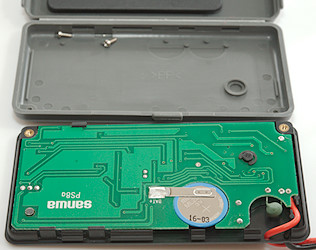
I only had to remove two screws to open the meter, if you have the spare part it is very easy to replace the box.
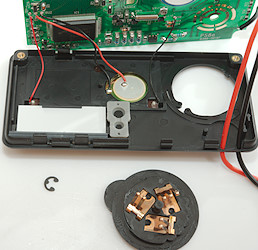
One circlip and I could remove the circuit board. At least partially, there was some wires resisting it.
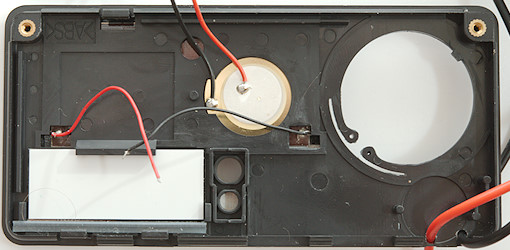
The front has the solar panel with two wires, a buzzer with two wires and a LCD display with a zebra stripe. The probes goes through holes in the front and requires soldering to remove.
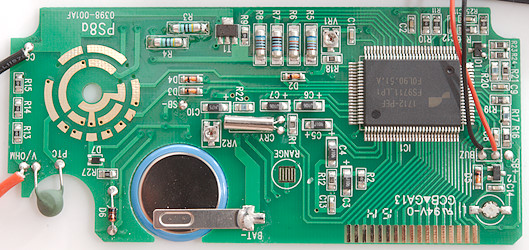
The voltage input uses two resistors (R3 & R4: 2x5Mohm). For the ohms and diode range there is a 3 resistor (R13, R14, R15: 3x300kOhm) input and a PTC output with a transistor (T1) clamp.
The charging circuit from the solar panel goes through a resistor (R27: 200ohm) and a diode (D7: Vf:0.3V)
There is an inductor (L1) mounted inside the circuit board near the LCD pads.
The multimeter is is a FS9711_LP1 (See datasheet for FS9721_LP1).

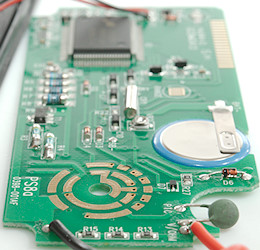
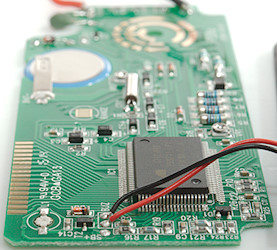

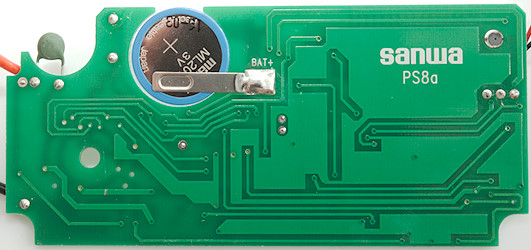
There is not really anything on this side.
Conclusion
This meter is not rated for mains use, the manual says to avoid transients, but the instruction sheet shows it used in a mains outlet.
The meter is a bit low on ranges with only voltage and ohm/continuity/diode, but at least it has a manual range option.
This meter looks like it is designed to keep in the pocket with occasionally use, the design do not look like it is made for heavy use. It needs to spend a day in the sun once in a while to stay charged.
Notes
How do I review a DMM
More DMM reviews
 : Continuity.
: Continuity.
 : Ohm.
: Ohm.
 : Diode.
: Diode.












 : Continuity.
: Continuity.
 : Ohm.
: Ohm.
 : Diode.
: Diode.











